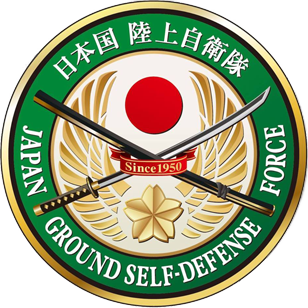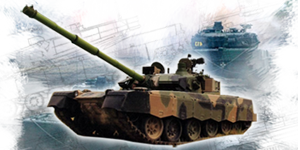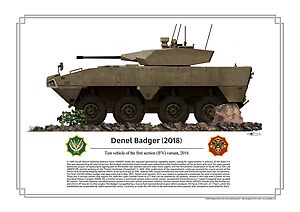Japan Ground Self-Defense Force
 Japan (1991-today): c150,000 active personnel + 60,000 reserve personnel, c4000 vehicles as of 2025
Japan (1991-today): c150,000 active personnel + 60,000 reserve personnel, c4000 vehicles as of 2025
Cold War Legacy
 During the Cold War (roughly 1947–1991), the Japanese Ground Self-Defense Force (JGSDF) [陸上自衛隊] or Rikujō Jieitai, played a crucial but constitutionally constrained role in Japan's national security, shaped largely by its pacifist postwar constitution and U.S. strategic interests in East Asia. It emerged after the post-WWII Demilitarization under the 1947 constitution (especially Article 9) renouncing war and prohibited maintaining traditional military forces. However Cold War Tensions & U.S. Pressure after the Korean War saw the US pushing Japan to rearm to help contain communism in Asia. The JGSDF was officially formed in 1954 under the Self-Defense Forces (SDF) law, along with the Maritime and Air Self-Defense Forces. It replaced earlier police reserve and security forces.
During the Cold War (roughly 1947–1991), the Japanese Ground Self-Defense Force (JGSDF) [陸上自衛隊] or Rikujō Jieitai, played a crucial but constitutionally constrained role in Japan's national security, shaped largely by its pacifist postwar constitution and U.S. strategic interests in East Asia. It emerged after the post-WWII Demilitarization under the 1947 constitution (especially Article 9) renouncing war and prohibited maintaining traditional military forces. However Cold War Tensions & U.S. Pressure after the Korean War saw the US pushing Japan to rearm to help contain communism in Asia. The JGSDF was officially formed in 1954 under the Self-Defense Forces (SDF) law, along with the Maritime and Air Self-Defense Forces. It replaced earlier police reserve and security forces.
Its Primary Mission was territorial defense, protecting Japan from potential invasion, especially from the Soviet Union or China.But it had an ingrained, deep non-offensive Posture due to constitutional limits, being strictly defensive. It lacked long-range missiles notably and a proper projection force. It core assignement was to defend Hokkaido, Japan’s northernmost island, from a potential Soviet invasion via the Kuril Islands. It was also tasked for Internal security and disaster relief. The JGSDF maintained around 150,000–180,000 personnel, not far from what it is today, despite demographic challenges and the end of the cold war.

The JGSDF famusly developed domestically its own tanks like the Type 61, Type 74, as well as its own helicopters, artillery, although still relying heavily on U.S. support for strategy and technology. Under the U.S.-Japan Security Alliance via the Mutual Cooperation and Security Treaty (1960), the U.S. procured extended deterrence, including nuclear protection over Japan. The JGSDF was appreciated for its support role, coordinated closely with U.S. Forces Japan (USFJ), as a local ground defense partner in the event of conflict with communist states.
However it met with Public Skepticism particularly from left-wing groups, opposing militarization due to wartime memories. There were also Legal and Political Constraints: The JGSDF could not operate abroad or engage in collective defense (interpreted as unconstitutional at the time). It had also limited NATO-Style Capabilities: Unlike other Cold War militaries, the JGSDF had no expeditionary capability and was often under tight political control.
However The JGSDF played a role in monitoring Soviet military activities, especially through Hokkaido and Japan's northern territories, which were strategic flashpoints in East Asia. As the Cold War wound down and the Soviet Union collapsed in 1991, Japan began modest reforms in its security posture, though the JGSDF remained primarily a defensive force. However now after 40 years had passed, almost as long as the cold war itself, the JGSDF seems to rearm. Notably in face of a growing Chinese expansion policy and territorial claims backed by a massive rearmament, more than ever a "new cold war" is emerging, especially after the 2022 Russian invasion of Ukraine.
Rapid Changes: The 2000s

In 1975 already, some in the Japanese Government estimated Japan lacked the depth to face an attack in force from USSR, having only resources for 4 days of fighting at best. However things started to evolved in 2004 when the Japan Defense Agency activated the Special Operations Group, with the mandate under the JGSDF of Counter-terrorist unit, ostensibly for foreign interventions, as well as at hime, notably after the Tokyo Metro sarin gaz attack. More so, in 2015, the Japanese Diet passed a law reinterpretation of Article 9 of the constitution, upon which JSDF personnel train with the American forces in amphibious assault units, to take outlying islands.
Another sign of great doctrinal and posture changes, Japan activated its first marine unit since World War II. This was effective on April 7, 2018. The "Amphibious Rapid Deployment Brigade" are trained to counter invaders from occupying Japanese islands at the southern edge of the East China Sea. But inherently they could operate onother operations. Despite not being part of NATO, the GSDF started to work with non-US forces as well, like an exercise with British troops of the Honourable Artillery Company (HAC)in Oyama, Shizuoka prefecture, on 2 October 2018. Threats from North Korea were answered by a pledge of common defense. The Japanese also trained with the Indian Army in the state of Mizoram from 27 October to 18 November 2018, first time since WW2 the Japanese forces showed in the area. Focus was not about countering China but more dipomatically for "anti-terror drills" and improve bilateral cooperation. Plus the detachmment was limited to 60 Japanese and Indian officers overall as observers.
By March 2019, the Ministry of Defense created for the first time a regional cyber protection unit subordonated to the Western Army, JGSDF to safeguard defense communications from likely North Korean, or Chinese cyber attacks, and secure personnel deployed on remote islands without secure lines wit an alternative solution. At the same time for the first time, a sizeable force of the JSDF was dispatched in peacekeeping operation not under UN the same year. JGSDF officers monitored the cease-fire between Israel and Egypt as part of a Multinational Force, and part of the Observers command in the Sinai Peninsula until 30 November 2019.
Also in 2021, from September to late November, the GSDF for the first time conducted the largest, nationwide drills ever since the creation of the force, all units being involved so around 100,000 personnel, 20,000 vehicles, 120 aircraft, coordination of the JMSDF and JASDF plus U.S. Army landing ship. At least it was the largest GSDF exercises since 1993. These are based on 2019 National Defense Program Guidelines promoted by Minister of Defense Nobuo Kishi for a more effective readiness to all situations.
(More to come)
Organization
(To come)Assets
Infantry
(To come)Softskin Assets

Mitsubishi Type 73 Kogata

Type 73 Light Truck (Mitsubishi), Light utility vehicle similar in function to the U.S. Humvee or Jeep. Variants: Personnel carrier, radio vehicle, command post 4x4 drive with open or closed cabin options, powered by a diesel engine. Often called the “JGSDF Jeep”; used for a wide range of utility tasks.
Type 73 Medium Truck from Hino and Isuzu, 2.5-ton class cargo and troop transport, 6x6, can carry up to 24 troops, tarp-covered cargo bed. Use for supply transport, field deployment, general logistics and Mitsubishi Fuso Type 73 semi-trailer truck.
Type 74 Medium Truck (Nissan Diesel), Heavier replacement for some Type 73 trucks, Improved load capacity. Used for container or equipment hauling
Type 60/Type 61 Utility Trucks. phased out but used during the early Cold War. Generally basic 4x4 or 6x6 utility vehicles
Toyota Mega Cruiser (High Mobility Vehicle), High mobility transport for rough terrain. 4WD, diesel. Similar to the U.S. Humvee in performance and appearance. Used by elite units and for command vehicles. Civilian Version: Toyota briefly released a civilian Mega Cruiser, but it was rare.
Light Armored Vehicle (LAV) Soft Skin Variant. The JGSDF operates armored LAVs, they also have soft-skin command and recon variants with reduced armor for mobility and logistics use. Specialized Soft-Skin Vehicles.
Toyota high-mobility vehicle 4-wheel-drive sport: 3,000 by Toyota. Production ceased in 2001.
Type 81 short-range surface-to-air missile truck Built by Toshiba.
Type 93 short-range surface-to-air missile truck Built by Toshiba.
Type 11 short-range surface-to-air missile truck Built by Toshiba.
Type 03 medium-range surface-to-air missile truck Built by Mitsubishi/Toshiba.
Type 12 surface-to-ship missile truck Built by Mitsubishi.
Type 88 surface-to-ship missile truck Built by Mitsubishi.
Ambulance Vehicles: Based on light trucks (Toyota HiAce or Mitsubishi platforms), configured with stretchers and medical gear.
Command & Communication Trucks: Often boxy vans or extended-cab trucks with antennae and internal comms gear.
Water and Fuel Tankers: Built on medium truck chassis for field operations.
Maintenance and Recovery Vehicles: Equipped with tools and cranes.
Civilian-Based Models in Military Use
The JGSDF also adapts civilian commercial vehicles for non-combat roles: Toyota Hilux (in training or base support roles), Mitsubishi Canter light trucks, Isuzu Elf small trucks
These are usually painted in olive drab or camouflage, sometimes with the JGSDF roundel (cherry blossom insignia).
Most JGSDF soft-skin vehicles are:
-Painted in green, dark olive drab, or camo
-Marked with unit designations and vehicle numbers in white
-Equipped with blackout lights, tow hooks, and sometimes snorkels
Airbone Assets




Typical JGSDF Aviation Use Cases: Rapid troop movement across mountainous or remote terrain, Anti-tank and fire support (AH-1S, AH-64D), Reconnaissance and battlefield surveillance (OH-1), Heavy logistics (CH-47JA), Large-scale disaster relief missions (e.g., 2011 Tōhoku earthquake/tsunami, Limited counter-invasion roles, especially in Southwest Islands (Nansei Shoto).
Types
Bell Boeing V-22B Osprey V/STOL military transport aircraft: 14 (17 planned total)Boeing AH-64SJP Apache: 13 built by Fuji. (1 crashed 5 February 2018)
Bell AH-1 Cobra (AH-1S): 40 Built by Fuji.
Kawasaki OH-1 Scout: 37, replaced the OH-6D fleet, based on Hughes Cayuse.
UH-60JA Black Hawk (Transport): 39, most built by Mitsubishi. 1 crashed 6 April 2023.
Bell UH-1J: 106, Built by Fuji. To be replaced by the Subaru-Bell UH-2.
Subaru-Bell UH-2: 9 (+ 21) +123, 150 planned to be ordered.
Boeing CH-47JCH-47JA Chinook: 49 Built by Kawasaki. +12 on order.
Unmanned Aerial Vehicles (UAVs) for battlefield recon and artillery spotting like the Fuji FFOS (Fuji Fire Observation System), small tactical drones
Organizational Structure
JGSDF aviation units are grouped into:-Central Readiness Force Aviation Group
-Regional Aviation Groups
-Regimental aviation companies/battalions
-Helicopter airbases include Kisarazu, Tachikawa, Akeno, and others
Nomenclature





















 Type 10
Type 10
Main battle tank: 111 (10 on order budget 2024) all built by Mitsubishi.
 Type 90
Type 90
Main battle tank: 340, all built by Mitsubishi until 2009.
 Type 89
Type 89
Mitsubishi Type 89 IFV (Infantry fighting vehicle): 70, all built by Mitsubishi and Komatsu.
 Type 16 MCV
Type 16 MCV
Wheeled tank destroyer: 100 (2023). Built by Mitsubishi. 250 total planned, 240 ordered in total as of 2024.
 Type 96 MPMS
Type 96 MPMS
Type 96 multi-purpose missile system Anti-tank/landing-craft missile; Built by Kawasaki.
 Type 87 RCV
Type 87 RCV
Reconnaissance vehicle; 111 built by Komatsu and 34 Chemical Reconnaissance Vehicles also by Komatsu. NBC Reconnaissance Vehicle (Chemical, biological, radiological and nuclear reconnaissance vehicle), 21 Built by Komatsu.
 Type 73 APC
Type 73 APC
Type 73 armored personnel carriers, 338 built by Mitsubishi.
 Type 96 WAPC
Type 96 WAPC
Type 96 wheeled armored personnel carrier: 400, built by Komatsu.
 Type 82 CCV
Type 82 CCV
Type 82 command and communication vehicle: 197 built by Komatsu. Similar in role to the American M1130 commander's vehicle.
 Komatsu LAV
Komatsu LAV
Komatsu LAV Armored car, 1,818 built until 2019.
 Bushmaster PMV
Bushmaster PMV
Bushmaster Protected Mobility Vehicle (Infantry mobility vehicle), 8 built by Thales Australia.
 AAV7A1 RAM/RS
AAV7A1 RAM/RS
AAV7A1 RAM/RS Amphibious assault vehicle, 52 Imported from BAE Systems.
 Type 11 ARV
Type 11 ARV
Type 11 Armoured Recovery Vehicle: 4 built by Mitsubishi.
 Type 90 AFV
Type 90 AFV
Type 90 Armoured Recovery Vehicle, 30 built by Mitsubishi.
 Type 78 AFV
Type 78 AFV
Type 78 Armoured Recovery Vehicle: 36 built by Mitsubishi.
 Type 91 AFV
Type 91 AFV
Type 91 Armoured Vehicle-launched Bridge, 22 built by Mitsubishi.
 Type 92 MCV
Type 92 MCV
Type 92 Mine Clearance Vehicle, using mine-clearing line charge system, built by Nissan Motor Aerospace division (pre-2000) and IHI Aerospace Co., Ltd./Hitachi.









































